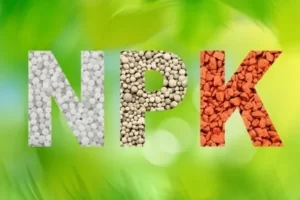
Looking at fertilizers in the store, you’ll usually find a grouping of numbers on the label. The numbers are important, and are required by law in most places. The numbers provide important information about what types of nutrients the fertilizer offers, and how much of each it contains.
What Do the Numbers on Fertilizer Mean?
Typically, there are three numbers on a fertilizer label separated by dashes, representing the percentage of N, P and K. What is NPK in fertilizer? Those three numbers correlate with the value of the three macro-nutrients used by plants: These macro-nutrients are nitrogen (N), phosphorus (P), and potassium (K), or NPK for short. Understanding the meaning of NPK will help you make the right decision for your plants.
The numbers indicate the percentage of these three elements in the fertilizer. The higher the number, the more concentrated that nutrient is in the fertilizer. For example, numbers on fertilizer listed as 20-5-5 means it has four times more nitrogen in it than phosphorus and potassium.
Many plants require a balanced fertilizer. A balanced number of 20-20-20 indicates the fertilizer has the same concentration of all three, and twice as much concentration of one that has 10-10-10.
NPK in Fertilizer
Here’s a brief description for each of these 3 nutrients:
Nitrogen (N) – Nitrogen is largely responsible for rapid growth of green leaves.
Phosphorus (P) – Phosphorus is largely responsible for root growth, as well as flower and fruit development.
Potassium (K) – Potassium is a nutrient that helps the overall functions of the plant perform correctly and supports the plant’s vitality. (Note that potassium is usually provided in the form of potash, also known as K2O)
The fertilizer numbers’ percentages are calculated by weight. The remainder of NPK fertilizer ingredients are generally sand or ground limestone, and sometimes micronutrients. Occasionally you will also see another number added to the fertilizer numbers. That final number represents the amount of sulfur in the mix.
A fertilizer that contains only one macro-nutrient will have “0” in the other values. For example, if a fertilizer is 10-0-0, then it only contains nitrogen.
These fertilizer numbers, also referred to as NPK values, should appear on any fertilizer you purchase, whether it is an organic fertilizer or a chemical fertilizer.
How to Choose the Right Fertilizer
The NPK numbers on fertilizer are a way to provide the nutrients that may be missing in your soil, which is why the soil test is important as a first step. Your soil may have plenty of one and not enough of the others. If you get your soil tested by an extension service, you’ll know which numbers to look for when you buy fertilizer.
Many soils have sufficient phosphorus and potassium for plants, but not enough nitrogen. And plants do not use as much phosphorus as nitrogen and potassium. That means that choosing the right fertilizer may mean picking a fertilizer with a higher first number or three different numbers like 16-8-2.
Knowing the NPK values of a fertilizer will help you select one that’s appropriate for the type of plant you’re growing. For example, if you’re growing leafy vegetables, you may want to apply a fertilizer that has a higher nitrogen number to encourage leafy growth. If you’re growing flowers, you may want to apply a fertilizer that has a higher phosphorus number to encourage more blooms.
How to Calculate for NPK Fertilizer
The next step is to measure your soil and calculate the square footage using the formula length times width. Then purchase fertilizer for the area.
The fertilizer numbers can be used to calculate how much of a fertilizer needs to be applied to equal 1 pound (0.45 kg) of the nutrient you are trying to add to the soil. So, if the numbers on the fertilizer are 10-10-10, you can divide 100 by 10 and this will tell you that you need 10 pounds (4.5 kg.) of the fertilizer to add 1 pound (0.45 kg) of the nutrient to the soil. If the fertilizer numbers were 20-20-20, you divide 100 by 20 and you know that it will take 5 pounds (2.2 kg) of the fertilizer to add 1 pound (0.45 kg) of the nutrient to the soil.
Applying Fertilizer
Always apply fertilizer according to directions. It’s important to use the recommended rates or even less. Using too much fertilizer is never a good idea and can burn your plants.
